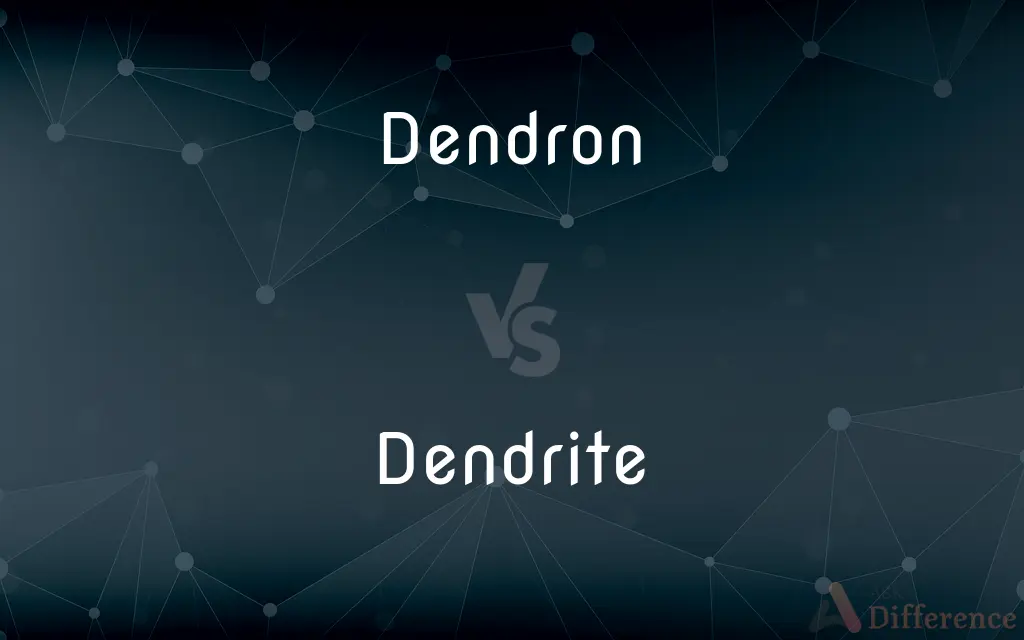Dendron vs. Dendrite — What's the Difference?
By Urooj Arif & Fiza Rafique — Updated on April 3, 2024
Dendron refers to the entire tree-like extension from a neuron, including its branches, while a dendrite is a specific branch of a dendron that receives signals from other neurons.

Difference Between Dendron and Dendrite
Table of Contents
ADVERTISEMENT
Key Differences
Dendrons serve as the neuron's receptive region, playing a critical role in integrating synaptic inputs and determining the neuron's response to stimuli. They can vary greatly in shape and size among different neuron types, which affects the neuron's connectivity and function. Dendrites, being components of dendrons, contribute to the complexity of synaptic integration by increasing the surface area available for synapses. This differentiation is crucial for understanding the hierarchical organization of neuronal structures and their role in neural processing.
The morphology of dendrites, such as their thickness, length, and the pattern of branching, directly influences the synaptic plasticity and the strength of neural connections. Dendrons, encompassing all dendritic branches, collectively determine the neuron's overall capacity to connect with and respond to other neurons. This distinction highlights the importance of structural variation within the nervous system in facilitating diverse neural functions.
Dendritic spines, small protrusions found on dendrites, are sites of synaptic contact with axons and are key to synaptic transmission and plasticity. While dendritic spines are features of dendrites, the concept of dendrons encapsulates the broader structural and functional context in which these spines operate, emphasizing the integrated nature of neural signaling pathways.
The distinction between dendrons and dendrites underscores the complexity of neural architecture and its functional implications. Understanding this differentiation provides insight into the mechanisms of neural communication and the structural basis of the nervous system's ability to process and transmit information.
Comparison Chart
Definition
The entire tree-like extension from a neuron's cell body, including all branches.
A specific branch of a dendron that receives signals.
ADVERTISEMENT
Role
Serves as the main receptive structure of a neuron for receiving signals.
Functions as a subunit of dendron for synaptic connections.
Composition
Comprises the entire branching network of a neuron.
Individual branches within the dendron.
Structural Complexity
Represents the collective structure of all dendritic branches.
Individual branches that contribute to the dendron's complexity.
Function
Integrates synaptic inputs from various sources.
Receives and transmits signals to the neuron's cell body.
Compare with Definitions
Dendron
Comprises all dendritic branches of a neuron.
Neuroscientists study dendrons to understand how neurons communicate.
Dendrite
A specific branch of a dendron that forms synaptic connections.
Dendrites increase the surface area for receiving synaptic inputs.
Dendron
Varies greatly among neuron types, affecting connectivity.
Variations in dendron morphology are essential for neural plasticity.
Dendrite
Ends in synapses that receive signals from other neurons.
Each dendrite is a critical point of contact for neural communication.
Dendron
The main apparatus for receiving signals in a neuron.
Dendrons play a critical role in the neuron's ability to process information.
Dendrite
Contributes to the dendron's overall complexity.
Dendrites are essential for the structural and functional complexity of dendrons.
Dendron
The collective branching structure of a neuron extending from the cell body.
The dendron's complex architecture facilitates extensive neural connectivity.
Dendrite
Directly influences synaptic plasticity and connection strength.
The morphology of dendrites affects the efficiency of signal transmission.
Dendron
Integral for the reception and integration of synaptic inputs.
The dendron's shape and size influence a neuron's functional capabilities.
Dendrite
Features dendritic spines, sites of synaptic contact.
Dendritic spines on dendrites are key to synaptic transmission.
Dendron
See dendrite.
Dendrite
Dendrites (from Greek δένδρον déndron, "tree"), also dendrons, are branched protoplasmic extensions of a nerve cell that propagate the electrochemical stimulation received from other neural cells to the cell body, or soma, of the neuron from which the dendrites project. Electrical stimulation is transmitted onto dendrites by upstream neurons (usually via their axons) via synapses which are located at various points throughout the dendritic tree.
Dendron
(cytology) A slender projection of a nerve cell which conducts nerve impulses from a synapse to the body of the cell; a dendrite.
Dendrite
A mineral crystallizing in another mineral in the form of a branching or treelike mark.
Dendron
(chemistry) A section of a dendrimer that includes the central atom or group.
Dendrite
A rock or mineral bearing such a mark or marks.
Dendrite
A branched protoplasmic extension of a nerve cell that conducts impulses from adjacent cells inward toward the cell body. A single nerve may possess many dendrites. Also called dendron.
Dendrite
(cytology) A slender projection of a nerve cell which conducts nerve impulses from a synapse to the body of the cell; a dendron.
Dendrite
(cytology) Slender cell process emanating from the cell bodies of dendritic cells and follicular dendritic cells of the immune system.
Dendrite
Tree-like structure of crystals growing as material crystallizes
Dendrite
A hermit who lived in a tree
Dendrite
A stone or mineral on or in which are branching figures resembling shrubs or trees, produced by a foreign mineral, usually an oxide of manganese, as in the moss agate; also, a crystallized mineral having an arborescent form, e. g., gold or silver; an arborization.
Dendrite
Short fiber that conducts toward the cell body of the neuron
Common Curiosities
What is a dendron?
A dendron is the entire branching structure of a neuron that extends from the cell body, encompassing all dendritic branches.
What is a dendrite?
A dendrite is a specific branch within a dendron that ends in synapses and is responsible for receiving signals from other neurons.
What makes dendrons important in neuroscience research?
Dendrons are important because they determine the overall capacity of a neuron to connect with others and integrate synaptic inputs, which is essential for understanding neural communication and processing.
How do dendrons and dendrites interact within the nervous system?
Dendrons and dendrites interact to facilitate complex neural networks, with dendrites providing the points of synaptic contact and dendrons integrating these inputs at a broader level.
What impact does the morphology of dendrons have on the brain's functionality?
The morphology of dendrons affects how neurons connect and communicate, influencing the brain's ability to process information, learn, and adapt.
How do dendrons and dendrites contribute to neural communication?
Dendrons provide the structural framework for receiving inputs across the entire neuron, while dendrites are the specific pathways through which signals are received and transmitted to the neuron's cell body.
Is there a difference in the functional importance between dendrons and dendrites?
While both are crucial for neural function, dendrites provide the direct contact points for synaptic transmission, whereas dendrons represent the larger structure that supports these connections.
How are dendrons and dendrites studied in neuroscience?
They are studied through various techniques, including microscopy and electrophysiology, to understand their structure, function, and role in neural circuits and diseases.
What role do dendritic spines play in neural connectivity?
Dendritic spines, found on dendrites, are crucial for forming synaptic connections and facilitating synaptic transmission and plasticity.
Can the structure of dendrites affect a neuron's function?
Yes, the structure of dendrites, including their length, thickness, and pattern of branching, directly affects synaptic plasticity and the strength and efficiency of neural connections.
Share Your Discovery

Previous Comparison
Disproven vs. Disproved
Next Comparison
Minimize vs. MinimiseAuthor Spotlight
Written by
Urooj ArifUrooj is a skilled content writer at Ask Difference, known for her exceptional ability to simplify complex topics into engaging and informative content. With a passion for research and a flair for clear, concise writing, she consistently delivers articles that resonate with our diverse audience.
Co-written by
Fiza RafiqueFiza Rafique is a skilled content writer at AskDifference.com, where she meticulously refines and enhances written pieces. Drawing from her vast editorial expertise, Fiza ensures clarity, accuracy, and precision in every article. Passionate about language, she continually seeks to elevate the quality of content for readers worldwide.
















































